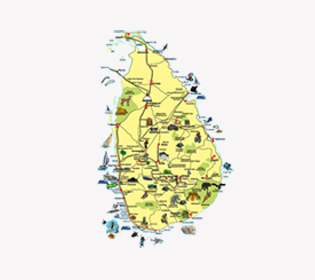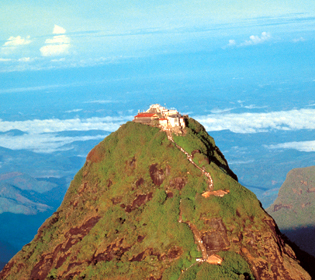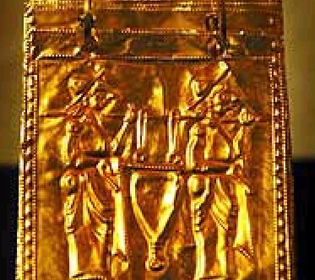
Taprobane, Serendib, Emerald Island and The Teardrop of India - Sri Lanka has earned many endearing monikers for its colorful past. In fact, the word "serendipity" (meaning the faculty to make fortunate discoveries by accident) originated in Sri Lanka in the 18-century, when the English writer Horace Walpole was so smitten by the place that he felt an urge to coin a word worthy of his lucky discovery.
The story of this eclectic nation began with mankind's need for one resource essential to its survival -water. Sophisticated irrigation systems emerged as early as the 1st Century A.D., leading to the birth of two great ancient Sinhalese civilizations: Anuradhapura in the center of the northern plain and Polonnaruwa, further southeast, near Mahaweli Ganga.
Anuradhapura, the first major capital city of Sri Lanka (4th Century B.C. - 8th Century A.D.), was famous for its flourishing monastic community and tradition of learning. The pursuit of knowledge led to the recording of history early on. Buddhist monks recounted Anuradhapura's development as far back as the 6th Century A.D. leaving behind the sacred scripture of Mahavamsa and its sequel, Culavamsa. The monastic accomplishments found their expression also in the construction of hemispherical domes called stupas or dagobas, a Buddhist architectural innovation imported from northern India. Sacred Buddhist relics are housed in these astonishing structures.
The next capital city, Polonnaruwa was the center of power until the 13th Century, boasting one of Sri Lanka's largest man-made reservoirs, as well as the ruins of once spectacular palaces, pleasure gardens and sculptural wonders. The irrigation projects initiated by King Parakramabahu I, especially the 5,940-acre Parakrama Samudra, have sustained the vibrant civilizations of Sri Lanka for hundreds of years.
Kandy (16th - 19th Century) was the third and last great Sri Lankan kingdom. The relocation of the country's capital ensured Kandy's significance as the permanent site of the Temple of the Tooth Relic and the Royal Palace. To this day, the tooth relic has anointed the city as the country's religious capital, serving as a place of pilgrimage for Buddhists from all over the world, especially during the Esala Perahera festival.
The early 16th Century also saw the arrival of foreign colonial powers that had a profound impact on the social and religious fabric of the country. Under Portuguese and Dutch rule, the Muslim community crystallized as an identifiable ethnic group. At the same time, missionaries brought with them Christianity. Even agriculture wasn't left untouched. The English introduced their plantation agriculture to Ceylon's economy in the mid-19th Century, focusing on three major crops - tea, rubber and coconuts. This rich plantation infrastructure has been a valuable resource to Sri Lanka, even after attaining independence in 1948.
For visitors, Sri Lanka's colorful tapestry of history, religion, architecture, wildlife and food makes it a fascinating place to explore.

It is worthy of note that an eyetooth remains the most significant religious symbol in Sri Lanka since Buddhism was first introduced to the Sinhalese in 250 B.C. This is no ordinary pointed conical tooth – it is believed to have belonged to Siddhartha Gautama, otherwise more popularly worshipped as the celestial Buddha. Its legendary power to bring rain to the land, made it the symbol of Sinhalese kingship, for whoever had the power to make the rain fall in the dry season and bring prosperity to the kingdom, had the legitimate right to rule the country.
The cause of wars between kingdoms, the sacred tooth relic was moved from Anuradhapura to Polonnaruwa, on to India and back to Sri Lanka. Today, this national treasure is housed in the Temple of the Tooth Relic (Dalada Maligawa) in Kandy, which has gained the reputation as one of the most sacred places of worship in the Buddhist world.
Aside from the Buddhist faith, which Sri Lanka inherited from India, exchanges between the two countries also brought with them the traditional caste system. Even monks are segregated into three nikayas or sects, according to the order of the Buddhist Sangha.
While Buddhism remains the predominant religion in the country today, Hinduism come a close second, counting among its devotees both Jaffna Tamils and Indian Tamils. Most Sri Lankan Hindus are Shaivites, who pray only to god Shiva, ‘the destroyer’, as they believe strongly in the teaching of non-permanence in all life forms.
Over the centuries, Sri Lanka has become a melting pot of believers. You will meet Muslims who are descendants of Arab traders, “Burghers” who are the offspring of European colonialists and embrace Christianity, as well as age-old Veddha tribes. Interestingly, a small percentage of the population consists of gypsies – the Ahikuntakaya snake charmers, the Maddiliya monkey trainers and several groups specializing in the art of tattoo making.

The resplendent island known to be Sri Lanka in its native language Sinhala continues to live up to its definition to be gleaming and brilliant. Perhaps the earliest inhabitants in this splendid country were the forefathers of the aboriginal group of people called Veddas who came as early as prior to 6th century B.C. before they were besieged by the next inhabitants. In between the 6th and 5th century B.C. came a large group of indo-Aryan ethnic people from the north of India called to be the Sinhalese which now comprise about three-fourths of the population. Sri Lanka is a neighbouring country of India therefore emigrations most likely came from different ethnic groups of different parts of India. Another ethnic group of people now emerged, emigrating from the Tamil region at the south of India forming the second largest group of inhabitants in the island, known as the Tamils. From these two major ethnicities bloomed the official language of the island – Sinhala and Tamil. From accounts, it was believed that they arrived sometime between the 3rd century B.C. and A.D. 1200.
In the 16th century, presumably 1505, the Portuguese settled in the land until the Dutch took over by trading spice in the 1658 to 1796. The English took over in 1796, translated the formerly Portuguese-named Celião into the English word Ceylon and claimed the country as their colony, where they developed the land from its produce, its government to its educational system. The native people arose during the World War I to claim their freedom, and its primary success was through the constitution of 1931. On February 4, 1946 Ceylon was recognized as a self- governing country in the Commonwealth of Nations. The name Ceylon was later changed into Sri Lanka on May 22, 1972 and at present it is now officially known as the Democratic Socialist Republic of Sri Lanka.

Sri Lankans are artistic people who enjoy music, dance and art in everything they do. The traditional agricultural life style made people come together to help each other in work. The gatherings for work created a nice atmosphere for dance and music. The Art, Music and dances of Sri Lanka were derived from the elements of Nature. The temple paintings and carvings used birds, elephants, wild animals, flowers and trees. The colors were made of nature.
Dance was then initiated in Sri Lanka during the 4th century B.C for the purpose of expelling natural disasters, sickness and greet people and land. At the end of Polonnaruwa period (15th century A.D.), chola influence came into Sri Lanka and was adopted in Sri Lanka folk dancing.
The classical dance forms are associated with the performance of various rituals and ceremonies which are centuries old and are based on the folk religion and folk beliefs going back to times before the advent and acceptance of Buddhism by the Sinhalese people in the third century B.C. These rituals and ceremonies reflect the values, beliefs and customs of an agricultural civilization of Sri Lanka. The main dancing styles of Sri Lanka are Kandyan Dancing, Sbaragamuwa dancing, Pahatharata dancing & Wanni Dancing
Elephants are the main attractions of Sri Lankan Religeous Festivals. Elephants are considered as divine animal in Buddhism and Hinduism. Elephants parade among dancers and drummers carrying caskets containing sacred relics. These festivals have been conducting over 2500 years.

"Ayurveda" is not just a form of medication that locals swear by, it is a total way of life known to generations of Sri Lankans for over 3000 years. It is a gentle method of treating the root cause of illness of both mind and body.It is a science of healthy living, and has two aims, to preserve health and to cure a body afflicted by disease.This holistic form of therapy utilizes the diet, herbs, oils, animal products, yoga and meditation to heal and rejuvenate both the body and mind.
Although Ayurveda can be enjoyed casually for its toning massages and herbal baths, it has a series of intense treatments that take over a period of weeks or even months and produce remarkable results. Ayurveda makes use of the island's natural resources like herbs, leaves, flowers, barks, roots and berries and uses them to cleanse the blood and the body of impurities.
It is claimed that many conditions can be alleviated or cured by Ayurveda, including arthritis, migraine, exhaustion, high blood pressure, depression, cystitis, asthma, nicotine and heroin addiction.

What does “The Hound of the Baskervilles” have to do with Ceylon tea? Read on.
“Those were the royal days of coffee planting in Ceylon, before a single season and a rotting fungus drove a whole community through years of despair to one of the greatest commercial victories which pluck and ingenuity ever won. Not often is it that men have heart when their one great industry (coffee) is withered, to rear up in a few years another (tea) as rich to take its place, and the tea fields of Ceylon are as true a monument to courage as is the lion at Waterloo.”
~ De Profundis, Sir Arthur Conan Doyle.
Sir Arthur's comments came in response to the disastrous demise of the coffee industry, which Ceylon overcame by trying its luck at growing tea, emerging eventually as a leader in the industry worldwide. The person who contributed to this success above all was a Scotsman named James Taylor, who dedicated his life to cultivating tea in Ceylon in the 1860s. Although he died a poor man the perfect cup of Ceylon tea has since become the sine qua non of our daily lives.
The phenomenon even caught Mark Twain’s attention back in 1896, when he noted in his journal “Following the Equator: A Journey around the World”:
“Tea-planting is the great business in Ceylon, now. A passenger says it often pays 40 percent on the investment. Says there is a boom”
The abundance of fragrant tea plantations in Sri Lanka today holds testament to this success. Nuwara Eliya is one of many places famous for producing Ceylon tea of the most delicate flavor and aroma. Its tea is exported to countries ranging from the United Kingdom to Russia, South Africa and the United States; providing that cup that "cheers you up" the world over.
Centuries before the tea trade boomed, the spice trade had attracted the Portuguese and the Dutch to the island of Sri Lanka, which was strategically placed on the sea route from India to Southeast Asia and China. The Dutch were promised a monopoly over the island’s spice trade by the Kandyan king, Rajasinha II, in return for their help in driving out the Portuguese. Yet, as fate would have it, having driven out the Portuguese, the Dutch decided to stay on themselves – an ironic twist in the story of control over Sri Lanka’s rich resources.
The Dutch presence pro lacerated the use of cinnamon, cardamom, cloves, nutmeg and black pepper in international cuisine through global trade. Ceylon’s cinnamon became the most sought-after for its superb ability to improve the palatability of food and its gift to add a sense of inner warmth to food cooked in cold climates.
When you visit Sri Lanka, it’s obligatory to visit a spice garden and have the owner explain the many wonderful properties and uses of each plant, from cooking and medicine to perfume. You can buy the freshest ingredients here to add that special flavor to your meals at home, or that refreshing cup of tea. Spice tea, anyone.

As the shimmering horizon disappears into the distant azure sky, tall gusts of waves surf towards the palm-fringed sandy beaches encircling Sri Lanka. This is paradise, blessed with soft white sand and wide-open vistas of the Indian Ocean. It's the perfect place to spend a relaxing beach vacation or a few days in the sun before continuing your journey to the Cultural Triangle.
The more popular beaches are located on the south coast, which is famous for its sunny weather and clear blue sky. Explore the laid-back charm of this region and and discover unusual and exciting attractions like the famous Kudawella blowhole on the rocky Unawatuna beach - a rare geological formation shooting huge columns of water high up into the air during the monsoon season. The famous stilt fishermen along the shores of Weligama present another spectacular sight, sitting for hours patiently on stilts in the ocean. While further down the coast, Hikkaduwa is perfect for snorkeling or taking a glass bottom boat ride, as the marine sanctuary there flourishes with an abundance of corals and tropical fish.

April is the month of reveal and revelry, the most intoxicating of the 12 months of the year, when Lanka and her people of the prepare to celebrate new beginning in harmony with mother nature. It is the season of the Avuruddha, the annual new year celebration by the Sinhala and Tamil people of the island, a great national festival which has persisted in all its traditional glory for no less than 2,000 years. Recognized officially and observed countrywide as the National New Year, the celebrations take seven days, varying only slightly from the age old venerable traditions which are still observed to the letter by Sri Lankan's of all ages and social background.
Sri Lankans celebrate their National New Year Aluth Avurudu in mid april after the Harvest is done. The sun moving from the House of Pisces to the Aries signals the dawning of the Sinhala and Tamil New Year. The New Year begins at the time determined by the astrologers.
The Avuruddha is heralded by the constant lighting of fire crackers and the unmistakable call of the koel bird, populary known as the koha which coos only once a year-at this time. Pay some attention to the multitude of sweet aromas flowing from country kitchens, which get crowded with clattering damsels preparing an assortment of coconut oil-based sweetmeats, which are high on the traditional holiday menu.
Hinduism, on the other hand, existed side by side with Buddhism, in medieval times. New Year practices interpreted in the Hinduistic way developed among the Hindus. Buddhism and Hinduism were historically connected with each other. Their philosophies were running along parallel dimensions, except for certain ultimate truths concerning the self, the way to achieve emancipation and the nature of a creative god and nirvana (which Buddhism denies). There was no serious contradiction in New Year rituals that are found among the Buddhists and Hindus.

Thai Pongal is a harvest festival equivalent to a thanksgiving event celebrated by Tamils across the world. Pongal coincides with the festival Makara Sankranthi celebrated in various parts of India. Pongal in Tamil means "boiling over or spill over." The act of boiling over of milk in the clay pot is considered to denote future wishes for the family.
It is claimed that many conditions can be alleviated or cured by Ayurveda, including arthritis, migraine, exhaustion, high blood pressure, depression, cystitis, asthma, nicotine and heroin addiction.
Makara Sankranti/Thai Pongal celebrates the resumption of the sun's 'journey northwards' where the days get longer. Tamil Hindus dedicate the first grain harvested to the sun on this 'Surya Mangalya'. Traditionally celebrated at harvest time, it's a celebration of the prosperity associated with the harvest by thanking the rain, sun and the farm animals that have helped in the harvest. In villages, new clothes are worn and people owning cows find this festival important.
The festival is celebrated four days from the last day of the Tamil month Maargazhi (December — January) to the third day of Thai (January — February).

Divali is a significant festival in Hinduismand an official holiday in Sri Lanka.Adherents of these religions celebrate Diwali as the Festival of Lights. They light diyas—cotton-like string wicks inserted in small clay pots filled with coconut oil—to signify victory of good over the evil within an individual.
Divali is a significant festival in Hinduismand an official holiday in Sri Lanka.Adherents of these religions celebrate Diwali as the Festival of Lights. They light diyas—cotton-like string wicks inserted in small clay pots filled with coconut oil—to signify victory of good over the evil within an individual.

Ramadan is the ninth month of the Islamic calendar. It is the Islamic month of fasting, in which participating Muslims refrain from eating, drinking, smoking, and indulging in anything that is in excess or ill-natured; from dawn until sunset. Fasting is meant to teach the Muslim patience, modesty and spirituality. Ramadan is a time for Muslims to fast for the sake of God, and to offer more prayer than usual. During Ramadan, Muslims ask forgiveness for past sins, pray for guidance and help in refraining from everyday evils, and try to purify themselves through self-restraint and good deeds. As compared to solar calendar, the dates of Ramadan vary, moving forward about ten days each year as it is a moving festival depending on the moon. Ramadhan was the month in which the first verses of the Qur'an were claimed to have been revealed to the Prophet Muhammad.

Common greetings during this holiday are the Arabic greeting or Happy Eid. In addition, many countries have their own greetings based on local language and traditions.
Typically, Muslims wake up early in the morning and have a small breakfast as a sign of not being on a fast on that day of preferably the date fruit, before attending a special Eid prayer that is performed in congregation at mosques or open areas like fields, squares etc. Muslims are encouraged to dress in their best clothes for the occasion. No adhan or iqama is to be pronounced for this Eid prayer, and it consists of only two raka'ahs. The Eid prayer is followed by the sermon and then a supplication asking for forgiveness, mercy and help for all living beings across the world. The khutbah also instructs Muslims as to the performance of rituals of Eid, such as the zakat.It is then customary to embrace the persons sitting on either side of oneself, whilst greeting them. After the prayers, people also visit their relatives, friends and acquaintances and some people also pay visits to the graveyards..

Kandy Asala Perahara is Sri Lanka’s Biggest and most colorful Festival watched by millions of people every year. The procession of the sacred Tooth Relic conducted annually during the month of July (Asala) constitutes the grandest festive ritual of the Dalada Maligava. Thousands of local and foreign visitors of all walks of life, irrespective of their religious pursuits, gather to the hill capital, Kandy, to rejoice in a festive mood on the days of this event.
Generally, the Devale processions in a mini scale are held for 5 days, followed by the `Kumbal' and `Randoli' processions each held for five days ending up on the Full moon day. The day following the last Randoli , the Water Cutting ceremony and the day procession are held bringing the festival to an end.

For many centuries, Christian writers accepted that Christmas was the actual date on which Jesus was born.However, in the early eighteenth century, scholars began proposing alternative explanations. Isaac Newton argued that the date of Christmas was selected to correspond with the winter solstice, which in ancient times was marked on December 25. In 1743, German Protestant Paul Ernst Jablonski argued Christmas was placed on December 25 to correspond with the Roman solar holiday Dies Natalis Solis Invicti and was therefore a "paganization" that debased the true church. In 1889, Louis Duchesne suggested that the date of Christmas was calculated as nine months after the Annunciation the traditional date of the Incarnation.



